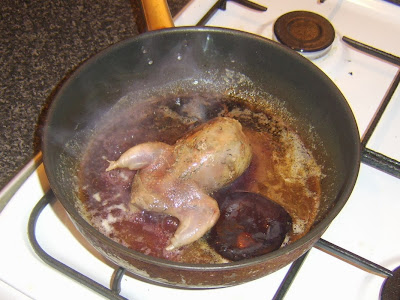 |
| Slow casseroled shoulder of pork with spicy apple sauce and roast potatoes |
Casseroling is a very popular way of cooking the tougher cuts of pork, such as leg and shoulder. If you are not careful, however, even the perfectly slow cooked meat can become dry and tasteless. This experiment involving cooking and subsequently briefly resting the meat while the casserole accompaniments are blended to form a sauce is something I believe worked very well.
It is also worth specifically pointing out the stock I used in this recipe. Usually, a pork casserole recipe will call for the use of chicken stock. I got to wondering why we never tend to make actual pork stock. I decided to give it a go and made my own homemade pork stock before incorporating it in this casserole.
 |
| Pork shoulder steaks |
Ingredients (Serves Two)
3/4 pound pork shoulder steak, chopped to about one inch chunks
Olive oil
1 Granny Smith apple, cored but not peeled and roughly chopped
1 medium white onion, peeled and quartered
1 large garlic clove, peeled and chopped
1 red chilli pepper, roughly chopped
Salt and pepper
1 teaspoon dried sage
3/4 pint fresh pork stock (or chicken stock)
12 new potatoes (or as required)
2 sprigs fresh rosemary
4 ounces trimmed green beans
 |
| Browning and sealing diced shoulder of pork |
Directions
Start your oven preheating to 180C/350F/Gas Mark 4.
Pour a little oil in to a large pot or saucepan and bring up to a medium heat. Add the pork and stir for two or three minutes with a wooden spoon to evenly seal all over.
 |
| Vegetables and fruit for pork casserole |
Carefully tip the pork in to a large casserole dish and pour the pork stock in to the empty pot. Heat the stock gently until it reaches a simmer.
 |
| Solid ingredients for pork casserole |
While the stock is heating, add the apple, onion, chilli, garlic and seasonings to the dish with the pork and carefully stir/fold to combine.
 |
| Pork stock is added to casserole ingredients |
Pour the heated stock in to the casserole dish, put the lid on and pop in to the oven for two hours.
As soon as the casserole is in the oven, add the unpeeled potatoes to a large pot, season with salt and pour in enough cold water to comfortably cover. Bring to a simmer for half an hour or so until the potatoes are softened. Turn off the heat and drain the potatoes at your sink. Return them to the pot and let them steam for five minutes before covering and leaving to cool completely.
 |
| Preparing potatoes for roasting |
Ten minutes before the pork is due to come out of the oven, pour two or three tablespoons of olive oil in to a small roasting tray and place it in the oven to preheat. Carefully peel the cooled potatoes with your fingers. When you remove the casserole from the oven, set it aside for a minute while you carefully stir the potatoes and roughly broken rosemary sprigs through the oil. Turn the oven up to 220C/450F/Gas Mark 8 and cook the potatoes for twenty minutes, stirring or shaking gently halfway through cooking.
 |
| Cooked pork is removed from casserole dish |
Take a minute or so to remove the pork chunks from the casserole with a large slotted spoon and a fork to a heated bowl and cover with foil. Ladle the gravy and vegetable pieces in to a blender and carefully blitz until smooth.
 |
| Blitzing apple sauce for pork |
Pour the blitzed gravy in to a pot and gently reheat. If you want it a bit thicker, add a teaspoon of cornflour/corn starch mixed to a paste with a little cold water and stir through for a couple of minutes.
 |
| Blitzed spicy apple sauce |
Take the potatoes from the oven and drain on kitchen paper while you blanche the beans for a couple of minutes in boiling, salted water.
 |
| Draining roast potatoes |
Plate the potatoes, beans and pork before spooning the gravy over the pork to serve.
 |
| Plating up casseroled pork, roast potatoes and trimmed green beans |














































